Maiden Rock Mine
Located in northwestern Wisconsin, Maiden Rock Mine is a private business adventure. The owners are interested in Bat Ecology and are working with David Redell of the DNR to help preserve the bat population that exists inside the mine. In August 2006 the new and improved 'second generation' bat detection system was installed into openings at Maiden Rock Mine.
Building upon the successes of the first detectors and redesigning the problem areas we have developed a new and improved bat detection system. The new system uses a focused and regulated infrared beam and a new power regulator. Most of the electronics is now wired onto a single circuit board that is housed inside a watertight polycarbonate case. The head units are smaller and easily attach to any size opening. The smaller head unit size and single circuit board design greatly simplify the adjustments done in the field. No focusing is necessary and the range of the new system is guaranteed between 2 - 10 feet.

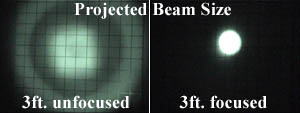
The new detectors use a focused infrared beam. This concentrates the infrared energy making the detectors more reliable and efficient. The focused beam makes the system easier to align and less sensitive to ambient light, producing better counts at dusk and dawn.
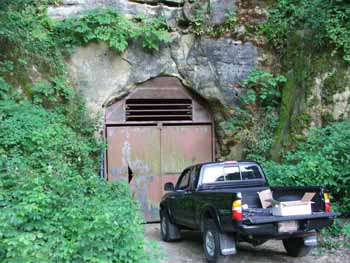 Physically the system components are smaller. The head units are built from 1 1/2" PVC pipe and connectors. The system is more environmentally secure (watertight) and incorporates a new mounting scheme. Redell has worked out a mountimg scheme that connects the head units directly to the bars of the security grid.
Physically the system components are smaller. The head units are built from 1 1/2" PVC pipe and connectors. The system is more environmentally secure (watertight) and incorporates a new mounting scheme. Redell has worked out a mountimg scheme that connects the head units directly to the bars of the security grid.
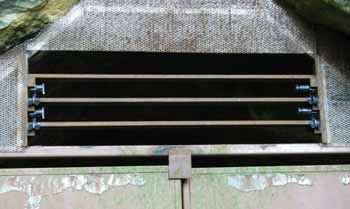
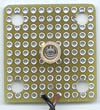
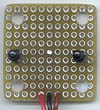
Other improvements are electronic regulation of the infrared beam’s intensity and a lower overall voltage requirement. Only 5.5 volts D.C. are needed for proper operation. This low voltage requirement makes the devices well suited for battery and solar operation.
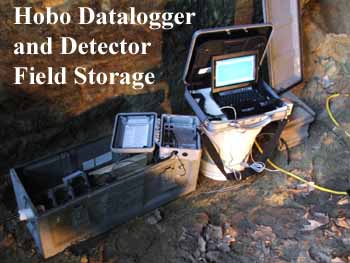
The data pulse outputs are optically isolated from the detector electronics and employ a universal 'open collector' arrangement that can accommodate any data logger device. The Maiden Rock installation uses a HOBO data logger for data recording.
The new system is easier to install, adjust and operate. It is capable of producing accurate data in remote locations. The low 5.5 vdc voltage requirement makes operation from 6 or 12 volt battery systems a snap.
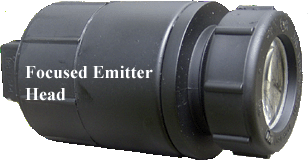
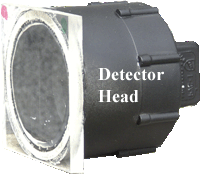
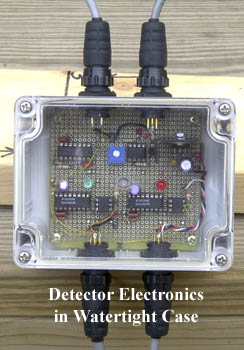 My work provides the physical devices and associated electronics to monitor the bat activity. I designed and built the prototypes and developed the watertight plug-and-play connector scheme that interconnects the system components. All components are electrically connected through the use of watertight plug-in connectors. The main detector circuit board is housed in a watertight polycarbonate case. The plug-in scheme makes installation and field troubleshooting a breeze.
My work provides the physical devices and associated electronics to monitor the bat activity. I designed and built the prototypes and developed the watertight plug-and-play connector scheme that interconnects the system components. All components are electrically connected through the use of watertight plug-in connectors. The main detector circuit board is housed in a watertight polycarbonate case. The plug-in scheme makes installation and field troubleshooting a breeze.
Redell’s work takes my devices into the field and installs them into crazy, unusual and hard to get at locations (mine openings) where the bats are hanging out. Using his great field knowledge and understanding of bat behavior he has developed a creative new mounting technique that securely mounts the head units into mine openings.
Redell's Master's Thesis: Behavioral Ecology of Bats using the Neda Mine Hibernaculum, University of Wisconsin-Madison, 2004 developed a way to count large numbers of bats using a statistically accurate method. Pairing observation with actual data his statistical procedure provides the scientific basis for accurate population counts inside the mine.
This ‘second generation’ attempts to create a universal system that is adaptable to any opening. The first sets have been installed into openings at the Maiden Rock Mine. Data is being clollected and analyzed. In the end we hope to put this technology to work with a Citizen-Based Bat Monitoring Partnership Program.
Contact:
Daniel Shurilla
Electronic Research Technician
Email: dannys@shurilla.com
David Redell, M.S.
Ecological Inventory & Monitoring
Bureau of Endangered Resources
Email: David.Redell@Wisconsin.gov
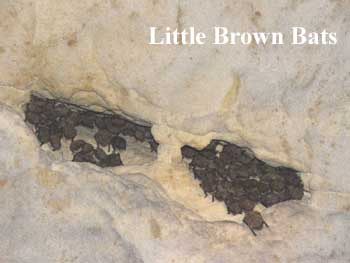
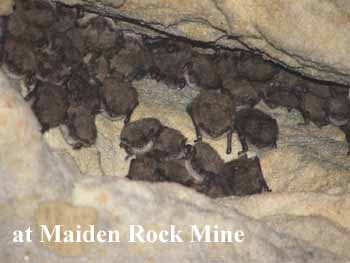




 Physically the system components are smaller. The head units are built from 1 1/2" PVC pipe and connectors. The system is more environmentally secure (watertight) and incorporates a new mounting scheme. Redell has worked out a mountimg scheme that connects the head units directly to the bars of the security grid.
Physically the system components are smaller. The head units are built from 1 1/2" PVC pipe and connectors. The system is more environmentally secure (watertight) and incorporates a new mounting scheme. Redell has worked out a mountimg scheme that connects the head units directly to the bars of the security grid.





 My work provides the physical devices and associated electronics to monitor the bat activity. I designed and built the prototypes and developed the watertight plug-and-play connector scheme that interconnects the system components. All components are electrically connected through the use of watertight plug-in connectors. The main detector circuit board is housed in a watertight polycarbonate case. The plug-in scheme makes installation and field troubleshooting a breeze.
My work provides the physical devices and associated electronics to monitor the bat activity. I designed and built the prototypes and developed the watertight plug-and-play connector scheme that interconnects the system components. All components are electrically connected through the use of watertight plug-in connectors. The main detector circuit board is housed in a watertight polycarbonate case. The plug-in scheme makes installation and field troubleshooting a breeze.